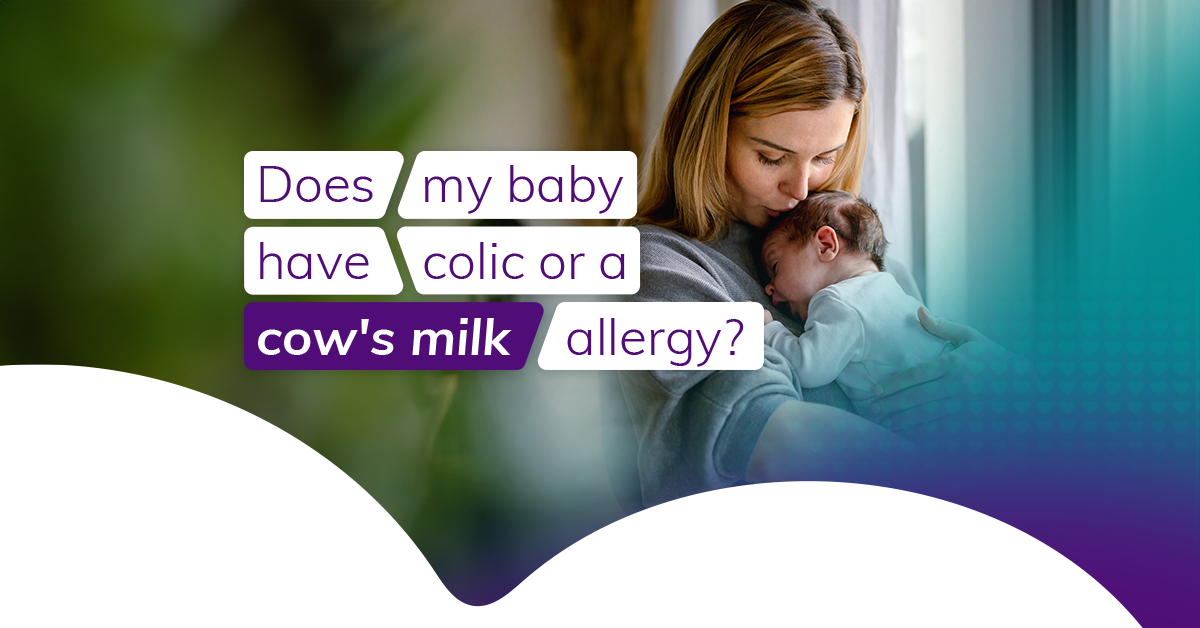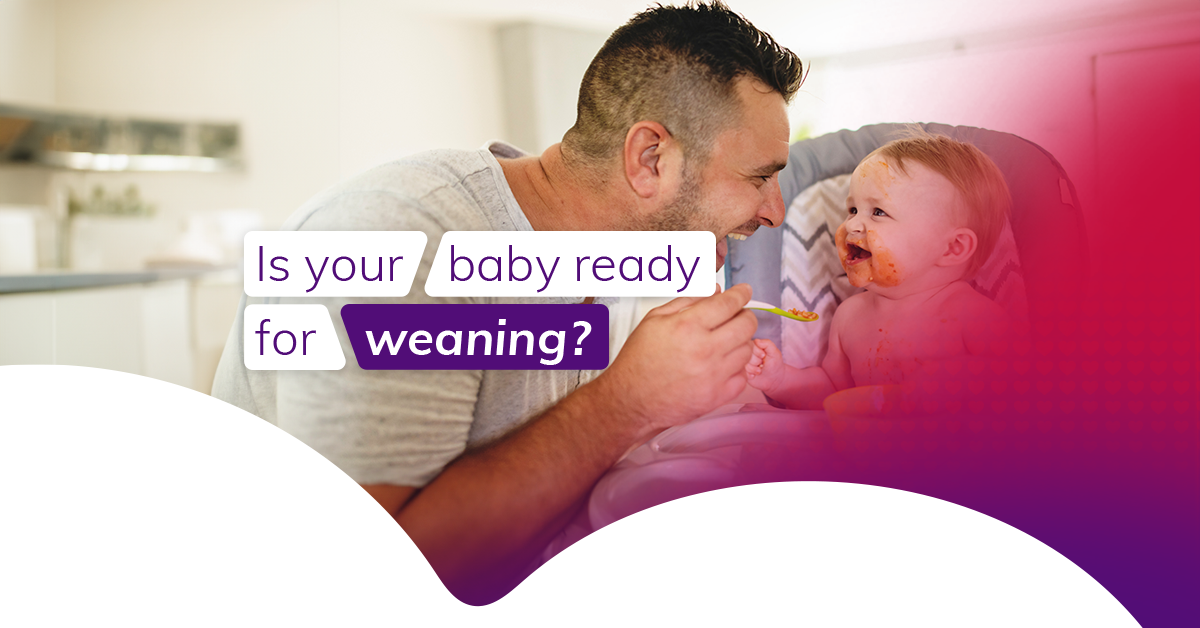

Does my baby have colic or a cow’s milk allergy?
Seeing your baby upset or in discomfort is upsetting for parents when all they want is to help their little one. Conditions like colic and cow’s milk allergy can have some similar symptoms, so the first step for parents is finding out which their baby has. Vhi consultant paediatrician, Dr Aisling Stafford, explains the differences and overlaps between the two, and what parents can do to help ease their baby’s discomfort.
It can be difficult to distinguish between cow’s milk protein allergy and colic in a baby. This is because some of the symptoms can overlap and present similarly. A cow’s milk protein allergy is also different to a lactose intolerance, although people commonly confuse the two. Let’s break down the facts about colic and a cow’s milk allergy first, then have a look at what makes a cow’s milk allergy different to a lactose intolerance.
Understanding colic
Colic is the name we give for excessive and frequent crying in babies that otherwise appear to be perfectly healthy. It has no certain or identifiable causes. Colic will affect up to 1 in 5 babies and will usually start when a baby is around two weeks old. It generally ends by the time your baby is about four months of age, but sometimes it will last until the baby is six months old. Babies with colic still thrive, grow, and gain weight as normal. How can you know if your baby’s crying is colic? It may be colic if your baby cries:
- For more than three hours a day
- For more than three days a week
- For more than three weeks
As soon as you think your baby could have colic, visit your healthcare provider for guidance. Colic crying is often more common in the evening time. Your baby’s cry will be loud and intense sounding. If your baby has colic, they’ll be restless and fussy. When they cry, they might draw their legs up and arch their back, tense their tummy or clench their fists. Their faces will go red as they cry, and it can be difficult to soothe them. This can be upsetting for parents to see, and although there is no treatment for colic, there are things you can do to try soothing your baby; hold them close when they cry, gently rock them, give them a warm bath or gently massage their tummy in circular motions (not after a feed). It’s recommended to sit your baby upright during their feeds, and to wind or burp them afterward. It may be helpful to avoid over-stimulation for babies with colic; keep loud noises, busy spaces or bright lights to a minimum for them as much as possible, not just during feeding.
Feeding a baby with colic
Depending on whether you formula feed or breastfeed your baby, there are some considerations to keep in mind if they have colic.
If you breastfeed your baby:
- Try emptying your milk in one breast during a feed before you change to the other breast. When breastfeeding, you create two types of milk, and the second half of your milk has more fat content. Fat slows down digestion, and this can help with your baby’s discomfort.
- Avoid drinking tea, coffee and any other drinks that have caffeine.
If you formula feed your baby:
- Try to minimise the amount of air in the bottle when you feed them.
- Feed your baby in the correct position, sitting upright in your lap or supported by your arm, with the bottle in a horizontal position so the teat is full of milk.
Adding a probiotic to your baby’s diet may help with colic symptoms, but speak to your healthcare provider before introducing any. When it comes to herbal remedies for colic, it’s a good idea to consult your healthcare provider first in this case too.
Let’s move on from colic to cow’s milk allergy to better understand the symptoms they have in common.
Cow’s milk allergy
Cow’s milk allergy is caused by your baby’s immune system reacting to the proteins found in cow’s milk. Breast milk and formula may both contain cow's milk proteins (if the breastfeeding parent drinks cow's milk). Formula is often treated to make the cow’s milk proteins within more digestible for babies, but if your baby has a cow’s milk allergy, your healthcare provider will advise on a prescription formula. Symptoms of cow’s milk allergy include bloating, tummy pain, gas, diarrhoea, vomiting, skin rash, wheezing or coughing. As you can see, these symptoms could cause your baby to react similarly as they would with colic; discomfort, crying, restlessness, and tensing their tummy. But, if your little one is experiencing the other symptoms above, such as vomiting, diarrhoea or skin problems, it might be an indication of a cow’s milk allergy. Your healthcare provider will be able to guide you on diagnosis and treatment.
Treating cow’s milk allergy
If your baby has a cow’s milk protein allergy, the management of the allergy will vary depending on whether your baby had an immediate allergic reaction (symptoms start within minutes and up to two hours after eating the allergen) or a delayed allergic reaction (symptoms start two hours up to 24 hours after eating the allergen), and whether they are breastfed, or formula fed. No matter if your baby is formula fed or breastfed, if they have an immediate allergic reaction to cow’s milk, stop giving them the milk straight away and reach out to your healthcare provider for next steps.
If your baby has a delayed allergic reaction and is formula fed, they will be given a prescription formula by their healthcare provider; this prescription milk is specially formulated and is the only formula recommended for the treatment of cow’s milk protein allergy in infants aged under 12 months. Oat milk, goat’s milk or soya milk are not recommended as a replacement for this age group. The first line prescription milk is called ‘extensively hydrolysed formula’. The proteins in milk that cause the problems for your baby are broken down into small particles in this prescription milk, so they won’t cause an allergic response and can be better handled by your baby’s gut. In highly rare cases, some babies will need milk with its proteins broken down even smaller, into amino acids. Both milks need to be prescribed with the guidance of your baby’s healthcare provider.
We leave them on this formula for some time, and then gradually (at weaning stage) we’ll start re-introducing the cow’s milk (with the support of a dietician) by following what’s known as the ‘milk ladder’. We start at the bottom of the ladder, where the milk is cooked or processed, which causes the protein to be changed and become less irritating for your baby’s gut. Foods on the bottom of the ladder would include biscuits or breads. As you climb the ladder, the milk is less processed, and your baby begins to tolerate this over time. Your baby can be brought back down a step on the ladder for a time if needs be, until they can progress with less processed milk and have no symptoms of allergy.
If your baby has a delayed allergic reaction and is breastfed, it is sometimes recommended that the breastfeeding parent will need to remove cow’s milk from their diet for a period decided on with their healthcare provider. It can then be re-introduced after some time, with the guidance of your healthcare provider and depending on whether your baby’s symptoms improved during that time. A breastfeeding mother requires 1200mg of calcium and 160 micrograms of iodine and 10 micrograms of vitamin D3 a day, on average. Any breastfeeding mother that is excluding milk and dairy products will be excluding the main sources of elemental calcium and iodine in the Irish diet. Appropriate dietary supplementation must be considered throughout the exclusion trial.[1]
Next, I’ll speak briefly about lactose intolerance so we can see how it differs from a cow’s milk allergy. It’s understandable why people confuse the two, as cow’s milk causes uncomfortable symptoms for both. But, with a lactose intolerance, goat and sheep milk also cause issues.
What is a lactose intolerance?
Having an intolerance to lactose is not the same as having a cow’s milk allergy. Lactose is the carbohydrate found in milk (cow, sheep and goat milks), and when you’re intolerant, your body can’t properly digest it, causing symptoms like bloating, discomfort, gas, and diarrhoea. The type of lactose intolerance we see most commonly in babies is called secondary or transient lactose intolerance, and it’s temporary. It’s usually triggered after a baby has had a viral infection, and their gut is a little inflamed so that it can’t break down lactose. Their gut can recover however, so we’ll usually place them on a lactose-free milk for about six weeks until their gut is healed. If you think your baby is having discomfort after consuming milk, be sure to speak to your healthcare provider to get a diagnosis, and don’t change milk before consulting them first. This is just in case it’s something other than a lactose intolerance at play.
When to see your healthcare provider
Symptoms like diarrhoea, vomiting, stomach pain, and irritability are common for various conditions, including colic and cow’s milk allergy, so it can be a bit confusing for parents to know what the root cause is. Your healthcare provider will be able to take a look at your baby, listen to the story of their symptoms and behaviours, and figure out what’s causing the upset. They’ll then choose an appropriate care plan for your baby and work through this with you.
Here’s a checklist of instances when you should bring your baby to see your healthcare provider:
- You’re not sure if your baby has colic or why they’re crying more than is usual.
- They’re vomiting and it’s green. This means they’re bringing up bile.
- They’re projectile vomiting (forceful vomiting).
- There’s any blood in their poo.
- They’re not feeding well.
- Their symptoms began after you introduced formula milk to their diet.
- They’re losing weight or not gaining any weight.
- You’re worried about them.
Colic and cow’s milk allergy do have some overlapping symptoms, but reactions like vomiting, wheezing, coughing, and rash are indicators of cow’s milk allergy rather than colic. If your baby displays any of the symptoms I’ve discussed in this blog, visiting your healthcare provider is the first step. With their help, you’ll figure out what’s causing your baby discomfort and find the best path forward.

This content is for information purposes only and is not intended or implied to be a substitute for professional medical advice, diagnosis, or treatment. Always seek advice from your GP or an appropriate medical professional if you have concerns about your health, or before commencing a new healthcare regime. If you believe that you are experiencing a medical emergency call 999 / 112 or seek emergency assistance immediately.
[1] Irish Food Allergy Network, https://www.ifan.ie/food-allergy-in-summary/pregnancy-and-breastfeeding/
Meet our Vhi Expert



